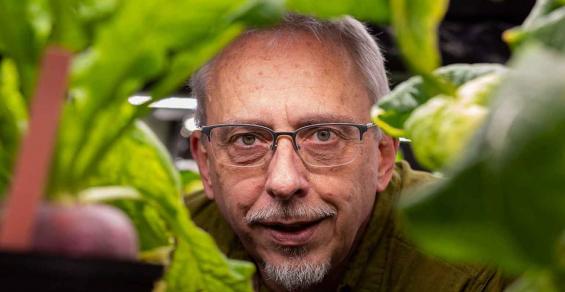Traditional agriculture is highly weather dependent, and producers of high-value crops are shifting from field production to controlled environment agriculture.
Next time you sit down to a crisp, green salad take a little time to think about where your leafy greens come from.
Traditional agriculture is highly weather dependent, and many producers of high-value crops are shifting over from field production to controlled environment agriculture. That is where the University of Georgia’s Marc van Iersel comes in.
Van Iersel, the Vincent J. Dooley Professor of horticultural physiology in the UGA College of Agricultural and Environmental Sciences (CAES), defines controlled environment agriculture, also known as CEA, as both greenhouse production that relies on natural sunlight and vertical farms that use an electrical light source.
Climate challenges
“One of the reasons a shift is happening is that 90% of all leafy greens produced in the United States are produced in California and Arizona. That area is in a megadrought and there is no end in sight. Because of this, they may not really be able to have water available to grow the crops in what is essentially a desert,” he said. Controlled environment agriculture is appealing to producers who are “looking for production systems that may not use as much water in controlled conditions where you can get predictable, year-long production.”
In his 27 years at CAES, van Iersel’s research has focused on developing sustainable and cost-effective ways to ensure that crops get the amount of light they need to grow.
“The greenhouse has to respond to weather conditions changing all the time,” he said. “You have shorter fluctuations from morning to afternoon to evening and year-long fluctuation in many parts of the United States in winter. You need to adjust to it.”
Based on his research, van Iersel co-founded Candidus — an agricultural technology company — in 2017 with Erico Mattos, who received his doctorate from UGA in 2013. The company provides lighting control systems that use a compact, powerful industrial microcomputer to monitor light sensors, calculate optimal lighting conditions, and control the lighting in controlled environment systems via a local Wi-Fi network.
“There was no one taking advantage of controlling light precisely in greenhouses,” van Iersel said. “We found we could reduce electricity costs for lighting by 30%, and given that, generally speaking, electricity cost for lighting is between 10 and 20% of operating costs for greenhouses, that can reduce operating costs by nearly half.”
The partners initially developed a system that responded to real-time levels of sunlight, but van Iersel has collaborated with electrical engineers to improve the system.
Predicting sunlight
Associate Professor of Horticulture Rhuanito Ferrarezi works to improve irrigation, nutrition and cropping systems in controlled environmental agriculture, focusing on vegetables and ornamentals.
“We’re focused on control algorithms where we can now predict the amount of sunlight we will likely get for the rest of the day, which helps us make better decisions on how much light we want to provide,” he said. “We also developed algorithms that allow the lighting system to respond to changing electricity prices. You don’t have the same electricity price over the course of the day. I believe the latest estimate from the Department of Energy has the United States spending about a billion dollars a year on electricity to provide light for crops that are grown in controlled environment agriculture.”
The responsiveness built into the Candidus algorithm has a significant effect on growers’ return on investment.
“You make a system that cuts the cost by 20% overall and that makes a critical financial difference,” van Iersel explained.
Among the most challenging parts of the work is convincing growers who have operated in a certain way for decades that a new system can provide real value to them. “Many are reluctant to change things, but some growers love trying new ways,” van Iersel said. “When you see more people doing well from trying something out, then you tend to feel more comfortable.”
Managing hydroponic system
In August 2021, Rhuanito Ferrarezi was hired as an associate professor of controlled environment agriculture in the CAES Department of Horticulture to leverage his expertise in production to help strengthen research capacity in controlled environment agriculture.
A main area of his work involves improving irrigation, nutrition and cropping systems, focusing on vegetables and ornamentals.
“My lab is trying to figure out what management systems should be used in hydroponic systems for controlled environment agriculture,” said Ferrarezi. “We also have a focus on figuring out how we manage the fertilizer solutions in a controlled environment to bring a benefit in using less fertilizer for production.”
One of the innovations Ferrarezi is working on is related to sap analysis, which uses leaf samples or soil substrate sampling to determine nutrient content in plant tissue.
“It is like a blood test for a plant,” he said. “We provide a snapshot of what is going on with the crop over a growing cycle. In a controlled environment, we have the ability to grow a crop quicker than out in the field. We can actually monitor the nutrient content inside a plant in real time and growers can either increase or decrease the fertilization based on those results.”
Ferrarezi believes that controlled environment agriculture will continue to attract increased attention from industries, with good reason.
“They are looking for ways to fine-tune production and controlled environment agriculture can help lead the way,” he said. “It’s an exciting time to be working in this area.”
UGA is a member of a consortium of land-grant institutions in the Southern region of the U.S. committed to finding workable solutions that conserve our natural resources, feed a growing world and improve our quality of living.




